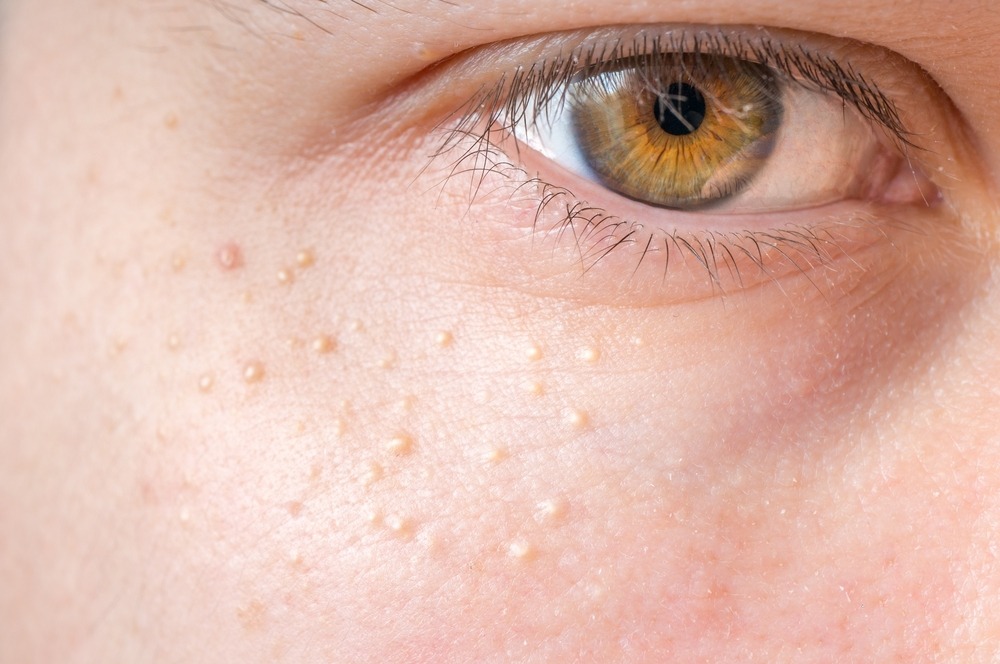What are Milia?
Milia are very common, pearly-white bumps, most commonly seen around the eyes and the upper cheeks. They are tiny cysts that contain keratin and sebum (lipid epithelial plugs or epidermal inclusion cysts). Milia are usually a dome-shape, 1-3mm in diameter, and sit just under the skin surface. They are often seen in clusters and can occur anywhere on the body.
Although milia are harmless and do not usually cause any problems or discomfort, some people do not like how they affect their cosmetic appearance.
Why do I get Milia?
There are two types of milia: primary and secondary.
Primary milia cysts contain keratin; they develop in the pilosebaceous follicle just under the skin. Primary milia are often seen on babies’ facial skin; people often call them milk spots. These milia nearly always go as the baby’s skin matures.
Milia seen in adults are less likely to go. Research suggests that milia in adults may be due to skin damage or using products containing mineral oil and lanolin. It suggests that milia arise because of a build-up of lanolin and mineral oil in the follicles.
Secondary milia occur due to skin trauma such as sunburn, radiotherapy or long-term steroid use.
How Can I Remove Milia?
Milia removal/treatment is not available on the NHS as they are a cosmetic problem. There are no prescription treatments currently available to help them.
Milia Removal with Topical Treatments
Occasionally, some milia improve with topical retinoids or alpha-hydroxy acids (AHAs). At Cheshire Lasers, we recommend Neostrata Eye Cream for parents prone to milia under the eyes, and our ph formula recovery or synergy serums for other less sensitive facial areas.
Milia Treatment with a Sterile Needle
Skin specialists often remove milia with a sterile needle. For this procedure to succeed, removing the whole milia is essential. This procedure usually leaves a small red mark /ulcer where the milia were, which often heals quickly.
Milia Removal with Hyfrecation
Hyfrecation is an excellent treatment for destroying and therefore completly removing the entire milia cyst. This involves a fine-tip needle delivering an electric current or radiofrequency energy into the lesion. At Cheshire Lasers, this is our treatment of choice for removing milia.
Dr Kathryn Hazlehurst and Surgeon Mr Will Allen usualy remove them using advanced electrocautery, and Helena Fryer removes them using advanced electrolysis.
These procedures usually leave a small red mark /ulcer where the milia were, which often heals quickly.
Milia Removal with Cryotherapy
Cryotherapy is an alternative treatment method. It freezes the cyst, leaving a small blister that can take over a week to resolve.
Prevention of Milia
If you are prone to Milia, you will find more will probably return over time. The use of retinol products and AHAs that stimulate cell renewal and encourage a faster skin cycle turnover can reduce the risk of them returning.
Also, it is crucial to avoid skin products which contain mineral oils and lanolin, as these increase the risk of recurrence.
Which areas can Cheshire Lasers treat?
Facial Surgeon Mr Will Allen, Dr Hazlehurst and Aesthetician Helena remove Milia from the face, including the under-eye area. Although it is unusual to get them elsewhere, they can easily be removed from the body. We recommend you see Moira or Dr Hazlehurst for body treatments to ensure the skin lesion is diagnosed correctly before treatment.
Could treatment leave a scar?
It is very unusual to be left with a scar after the removal of Milia. A small red mark /ulcer usually develops after treatment of the milia and heals very quickly.
Prices for Milia Removal
View Surgeon Mr Will Allen’s prices here.
Dr Kathryn Hazlehursts Prices are here
View Helena Fryer’s Milia removal prices using advanced electrolysis here.


